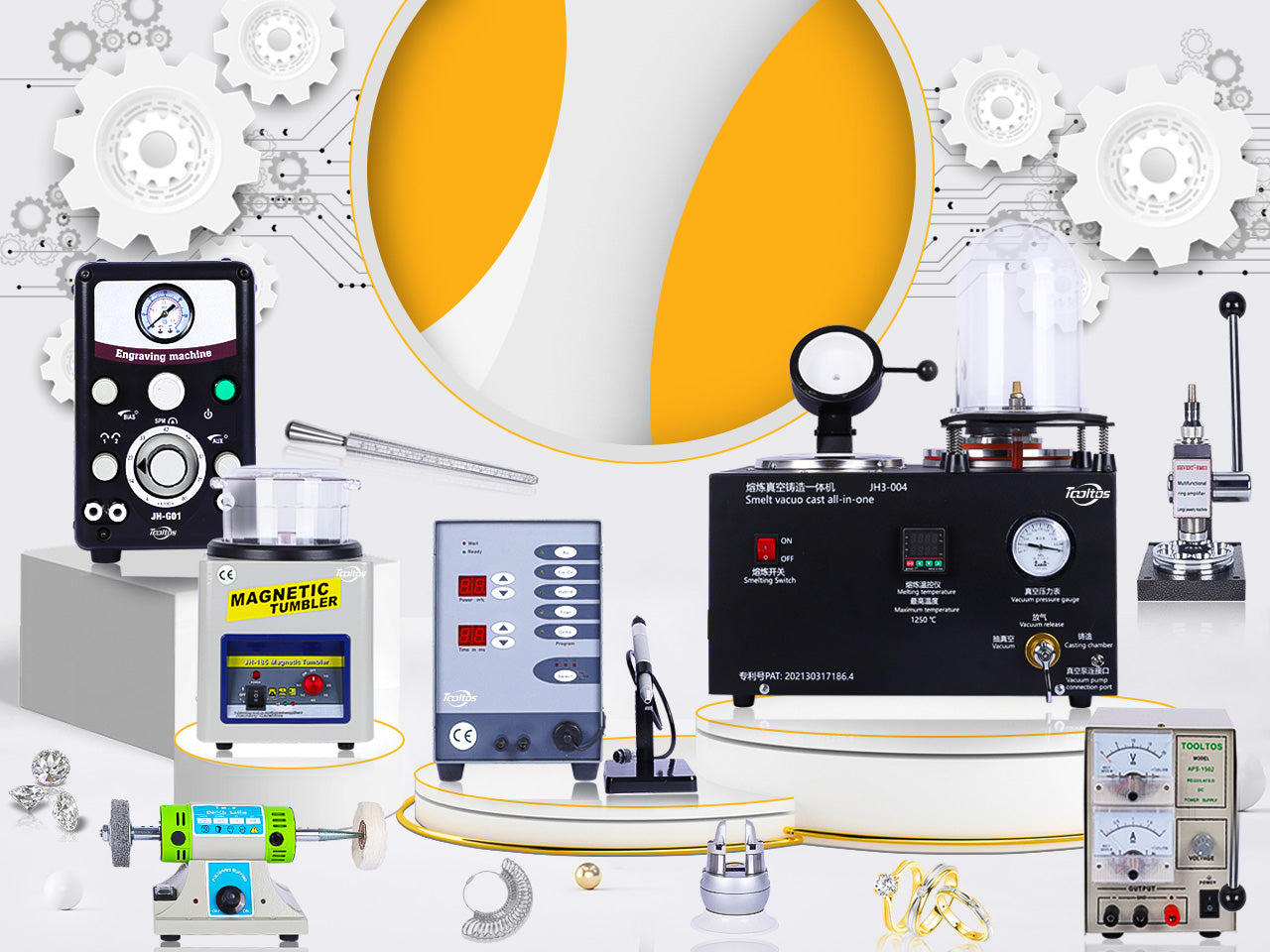Wenn Sie an traditionelle Metallarbeiten gewöhnt sind, kann es zunächst schwierig sein, sich an ein Verfahren wie Wachsschnitzen anzupassen. Bei der Herstellung von Metallschmuck fügen Sie dem Grundstück normalerweise dekorative Elemente hinzu, sei es Edelsteine oder dekorative Galeriestreifen. Bei wachsgeschnitztem Schmuck ist jedoch das Gegenteil der Fall. Sie beginnen mit einem Stück Wachs und ziehen es langsam ab, um schließlich Ihr Design freizulegen. Daher erfordert das Erlernen der Wachsschnitztechnik viel Zeit und Übung, aber die Ergebnisse unterscheiden sich stark von traditionellen Metallbearbeitungstechniken.
Aus diesem Grund haben wir dieses Handbuch erstellt, um Ihnen das Wachsschnitzen für die Schmuckherstellung beizubringen und Ihnen die Wachsschnitzwerkzeuge und -schritte näherzubringen, die Sie zum Perfektionieren Ihrer Wachsschnitztechnik benötigen.
Einführung in Wachsmodellierwerkzeuge
- Wachsröhrchen oder -blöcke
- Wachsring-Sticks
- Skalpelle
- Wachsklingen für Stichsägen
- Wachsfeilen
- Wachsschnitzwerkzeug-Sets
- Alkohollampen
- Methylierter Alkohol
Grundlagen: Wie schnitzt man Gusswachs?
Welches Wachs ist für Sie am besten geeignet?
Wachsröhren : Wenn Sie einen Ring herstellen, sind Wachsröhren die beste Wahl. Wachsröhren können mit einer Wachssäge abgeschnitten werden und der Überschuss kann aufbewahrt und wiederverwendet werden. Achten Sie darauf, eine Wachsröhre mit einem Loch in der Mitte zu wählen, damit Sie den Ring beim Schnitzen mit einem professionellen Wachsringstab leicht auf die richtige Größe bringen können.
Wachsblöcke : Sie möchten einen Anhänger, eine Brosche oder ein großes Amulett herstellen? Wenn Sie erhabene Reliefmuster erstellen möchten, die mit Blech allein nur schwer zu erstellen wären, sind Wachsblöcke eine gute Wahl. Da Wachs Kurven und weiche Formen erzeugt, können Wachsplatten verwendet werden, um natürlichere Szenen darzustellen. Denken Sie an traditionelle Reliefs und wie schön sie sich anfühlen würden. Mit einer Wachsplatte, den richtigen Wachsschnitzwerkzeugen und etwas Konzentration können Sie ganze Szenen mit Blumen, Tieren oder Skulpturen erstellen.
Wachsdraht: Auch wenn Sie sich beim Abziehen des Wachses Zeit gelassen haben, um Ihr Design freizulegen, können Sie auch Wachsfäden verwenden, um den letzten Schliff zu verleihen. Wachsdraht gibt es in verschiedenen Formen, beispielsweise rund, quadratisch, oval und sternförmig. Diese Wachsdrahtlängen sind flexibel und können verwendet werden, um dem Gesamtdesign ein dekoratives Element hinzuzufügen.
Wachsschnitztechnik
So gelingt Ihr Design
Wenn Sie ein geprägtes oder Reliefbild auf einem Wachsblock erstellen, beginnen Sie am besten mit einem Referenzpunkt. Haben Sie ein Bild, auf das Sie sich beziehen möchten? Sobald Sie ein maßstabsgetreues Bild haben, befestigen Sie es am Wachsblock und ziehen Sie es vorsichtig an den Rändern des Bildes entlang, sodass Sie einen groben Umriss haben. Dies wird Ihnen bei der Arbeit helfen. Denken Sie daran, dass Sie in dieser Phase nur den Umriss des Designs in das Wachs ritzen oder markieren müssen. Übertreiben Sie es nicht – die Details kommen später.
Wenn Sie regelmäßig Wachsröhren für Ringe und Anhänger verwenden, müssen Sie das Design möglicherweise mit einem Marker umreißen, bevor Sie mit dem Schnitzen des Wachses beginnen. Dieser muss jedoch während des Schnitzvorgangs erneut aufgetragen werden, falls Sie vom Weg abkommen und die Markierung verfehlen. Manche Menschen können Wachsfiguren mit bloßen Händen schnitzen, aber dies erfordert viel Übung und Konzentration, da Sie die Richtung der Schnitzerei immer vor Ihrem geistigen Auge sehen müssen.
Kratzen, Schaben und Gravieren
Das Schnitzen von Wachs für das Wachsausschmelzverfahren ist keine exakte Wissenschaft. Das Schöne daran ist, dass Sie ganz einfach mit einem Skalpell und einigen Wachsfeilen loslegen können. Ganz gleich, wie erfahren Sie sind, hier sind unsere Tipps zum Wachsschnitzen, die Ihnen helfen, das Beste aus Ihren Materialien herauszuholen:
- Machen Sie langsam! Wachsschnitzen erfordert keine rohe Gewalt. Beim Schnitzen geht es vor allem um Technik. Nehmen Sie sich daher beim Schnitzen und Abschaben des Wachses Zeit. Je langsamer und gemessener Ihre Bewegungen sind, desto wahrscheinlicher ist es, dass Sie Fehler vermeiden und nicht von vorne beginnen müssen. Dies bedeutet auch, dass Sie beim Schnitzen die Gesamtstruktur des Wachses nicht schwächen.
- Passen Sie die Position an. Verwenden Sie Schnitzmesser und Schaber, um Ihre Designs genauer herauszuschnitzen? Denken Sie daran, die Position Ihrer Werkzeuge anzupassen, um sicherzustellen, dass Sie bei jedem Gebrauch Material entfernen.
- Perfektion ist nicht alles. Der gesamte Wachsschnitzprozess kann anfangs sehr chaotisch, langsam und schwierig sein. Aber lassen Sie sich davon nicht abhalten. Denken Sie daran, dass das 3D-Design, das Sie anstreben, in Wirklichkeit möglicherweise nicht perfekt ist. Erwarten Sie also am Anfang nicht zu viel von sich selbst. Das Gute am Wachsschnitzen ist auch, dass Sie Fehler leicht korrigieren können. Und sobald Sie das perfekte Design geschnitzt haben, wird es gegossen, sodass Sie es immer wieder neu erstellen können.
- Setzen Sie die Hitze effizient ein. Denken Sie daran, dass Sie beim Verwenden von Schab- und Schnitzwerkzeugen die Spitze des Werkzeugs erhitzen können, indem Sie es vorsichtig und schnell in die Flamme einer Sprinklerlampe halten. Dadurch geht das Schnitzen schneller und einfacher. Mit lokaler Hitze können Sie auch unerwünschte Falten und unebene Kanten beseitigen.
- Ergänzungen und Reduzierungen. Während es beim Wachsmodellieren in erster Linie darum geht, überschüssiges Material zu entfernen, sollten Sie bedenken, dass Sie auch heißes Wachs zu vorhandenen Teilen hinzufügen können, um erhabene Elemente zu bilden. Sobald Sie sich an diese Technik gewöhnt haben, können Sie Ihren Designs sogar Anhänger und Accessoires hinzufügen, was Ihnen nach Abschluss des Wachsgusses viel Arbeit erspart.
- Fügen Sie Ihrem Set eine weiche Zahnbürste hinzu. Während Sie arbeiten, werden Sie feststellen, dass Ihre Designs (und Sie selbst!) dazu neigen, ein paar kleine Wachsflocken abzubekommen. Ein paar Wischbewegungen mit der weichen Zahnbürste über das Wachs stellen sicher, dass kein überschüssiges Wachs im Weg ist, und Sie können das Design klarer sehen, während es Gestalt annimmt.
Unebenheiten mit geschmolzenem Wachs ausbessern
Es lässt sich nicht leugnen, dass das Erlernen des Schnitzens von Schmuckmustern aus Wachs schwierig sein kann. Unabhängig von Ihrem Können in der Schmuckherstellung wird irgendwann die Zeit kommen, in der Sie einen Fehler beim Wachsschnitzen korrigieren müssen. Ob es darum geht, einen Riss zu reparieren oder mehr Wachs hinzuzufügen, um zu viel Wachs auszugleichen, es gibt ein paar Dinge, die Sie beachten müssen:
- Beheben Sie den Fehler mit Wachsresten. So bleiben die Kosten niedrig und Sie haben immer noch genügend Material für die notwendigen Reparaturen.
- Um die bestmögliche Verbindung zwischen dem Wachsblock/der Wachsröhre und dem Reparaturwachs herzustellen, achten Sie darauf, dass Sie zuerst das Originalwachs erhitzen. Dadurch kann sich die kristalline Struktur des Wachses beim Abkühlen und Trocknen wieder verbinden, was zu einer stärkeren Verbindung zwischen den beiden Wachsen führt.
Vorbereitung zum Casting
Sie können einige Schritte unternehmen, um sicherzustellen, dass Ihre Wachsskulptur keine übermäßigen Ecken und Kanten aufweist, bevor Sie mit dem Wachsausschmelzverfahren fortfahren.
- Legen Sie den Entwurf Ihrer Wachsskulptur in eine kalte Flamme. Dadurch schmelzen alle winzigen, unerwünschten Wachsspäne, die Teil des Gesamtentwurfs werden.
- Runden Sie die Kanten Ihrer Ringe und Anhänger mit einer Wachsfeile ab, um sie sauber und gleichmäßig zu machen. Denken Sie daran, nach dem Feilen Schleifpapier zu verwenden, um Feilspuren aus dem Design zu entfernen.
- Ist die Oberfläche des Designs eben? Verwenden Sie feines Schleifpapier, um alle unebenen Kanten zu glätten.
- Viele Juweliere behaupten, dass das Polieren von Wachsskulpturen mit einem kleinen Stück einer alten Strumpfhose eine gute Möglichkeit ist, um sicherzustellen, dass Ihr Design während des Gussvorgangs glatt ist.
Welche Wachsmodellierungswerkzeuge beschleunigen Ihren Prozess?
Wenn Sie gelernt haben, wie man mit einfachen Handwerkzeugen Schmuckfiguren aus Wachs formt, möchten Sie Ihren Prozess vielleicht mit einigen fortgeschrittenen professionellen Werkzeugen beschleunigen. Die Investition in eines oder mehrere der folgenden Wachsschnitzwerkzeuge hilft Ihnen nicht nur, Ihre Produktion zu beschleunigen, sondern Ihren Kunden auch genau das gewünschte Aussehen zu bieten.
Fortschrittliche Wachsgravurwerkzeuge
Pendelbohrmaschine oder Werkzeug mit biegsamer Welle : Wenn Sie mit Metall arbeiten, besitzen Sie wahrscheinlich bereits eine Pendelbohrmaschine oder ein Werkzeug mit biegsamer Welle. Mit einem Elektrowerkzeug können Sie gezielt Grate aufnehmen und so den Wachsvorgang erheblich beschleunigen.
Wachsfräser: Sie können spezielle Schaber, Steinsetzfräser und Finishingfräser passend zu Ihrer Hängebohrmaschine oder Ihrem Werkzeug mit flexibler Welle auswählen, um das Wachsschnitzen zu erleichtern.
Wachstrimmer und Bench Mate: In Verbindung mit einem Bench Mate und Ihrem Pendelbohrer können Sie mit einem Wachstrimmer eine vollständig flache Oberfläche erzeugen oder Ihre Drehbank so gestalten, dass das Wachsschnitzen beschleunigt wird.
Elektrischer Wachs-Skulpturstift : Wenn Sie in Zukunft viel Wachs verwenden möchten, ist dies eine hervorragende Investition. Damit können Sie Fehler schnell und effizient beheben, und der Stift heizt sich für Sie auf, sodass Sie sich bei Bedarf auf den Wiederaufbau der Schnitzelemente konzentrieren können.
Mit viel Übung und ein wenig Fantasie kann das Schnitzen von Wachs der Schlüssel zu einer ganzen Reihe neuer Ideen für die Schmuckherstellung sein, die Sie mit herkömmlichen Werkzeugen und Techniken der Metallschmiedekunst einfach nicht umsetzen können. Investieren Sie in einige grundlegende Werkzeuge und Ausrüstung zum Wachsschnitzen, bevor Sie einen Schritt weiter gehen und in fortgeschrittene Werkzeuge investieren.


0 Kommentare